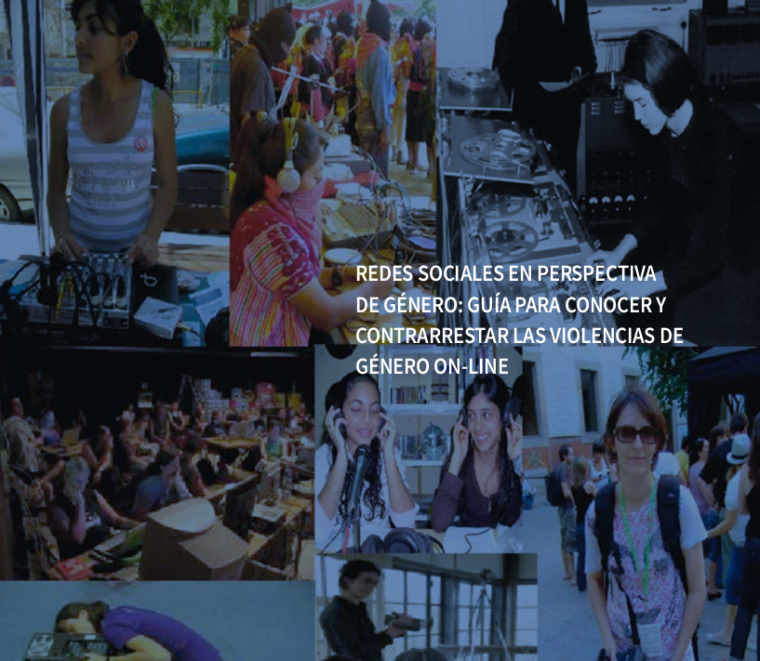"Redes Sociales en Perspectiva de Género: guía para conocer y contrarrestar las violencias de género on-line", por Donestech
(English version below)
Las redes sociales en Internet nos permiten conectarnos, intercambiar ideas y recursos, y promover transformaciones políticas. Sin embargo, estas tecnologías son también usadas para agredir u oprimir. Las violencias de género online traspasan múltiples capas de las experiencias e identidades de las mujeres, así como de las personas disidentes de género. Los distintos ataques machistas y neomachistas se traducen en intimidación, coerción, exposición, tentativas de control y deslegitimación personal, psicológica y política. Mapear estas prácticas y comprender cómo son reproducidas es fundamental para superarlas y construir espacios online seguros, libres e inclusivos. Activistas de DonesTech han publicado el manual Redes Sociales en Perspectiva de Género: guía para conocer y contrarrestar las violencias de género on-line. Este trabajo aborda de forma crítica y sencilla las formas de violencia de género en los espacios on-line, como gaslighting, doxxing y flaming. Además, la guía presenta ejemplos y diversos datos cuantitativos y cualitativos para elaborar un diagnóstico (ciber)feminista de las formas de esta violencia. Por último propone formas de autocuidado, protección y autodefensa, o como contrarrestar dichas violencias. La primera parte de la publicación comienza trazando un panorama del concepto de redes sociales, estructuras sociales estudiadas durante más de un siglo por filósofos y sociólogos y cuyas propiedades son replicadas en las redes sociales digitales. Además, las autoras critican las distorsiones de poder y la explotación de datos por plataformas comerciales como Facebook y Twitter. El trabajo muestra cómo el debate sobre la privacidad y la seguridad online, bajo un enfoque de género e interseccional, resulta crucial en nuestra sociedad hiperdigitalizada, heteropatriarcal y machista. La segunda parte del manual, además de profundizar en la caracterización de las formas de violencia online y los modos de acción de los agresores, apunta estrategias, recomendaciones y acciones de autodefensa. La guía se propone ser accesible y útil a mujeres y colectivos en diversos contextos políticos, y tiene las condiciones para serlo. El manual consigue desmitificar concepciones optimistas de los usos de plataformas digitales, y arrojar luces sobre las experiencias, muchas veces traumáticas, de las mujeres y personas disidentes de género en estos espacios. Su contribución es imprescindible para la lucha por una Internet realmente libre y segura no solo para algunos, sino para todas, sin distinción de género, sexualidad, raza, clase o condición.
Online social networks are political arenas that facilitate connecting, exchanging ideas and resources, and promoting political transformations. However, these technologies can be used for aggression and oppression at the same time. Online gender violence transcends multiple layers of the experiences and identities of women and gender dissident people. The different attacks of machistas and neomachistas translate into intimidation, coercion, exposure, attempts at controlling their victims, and personal, psychological and political delegitimization. Mapping these practices and understanding how they are reproduced by aggressors is critical to combat them and build safe, free and inclusive online spaces. Activists of the group DonesTech have published, in 2017, the manual Redes Sociales en Perspectiva de Género: guía para conocer y contrarrestar las violencias de género on-line. The material addresses in a critical and simple way the forms of gender violence in online spaces, such as gaslighting, doxxing and flaming. In addition, the guide brings examples and delves into quantitative and qualitative data to present a (cyber)feminist diagnosis of forms of online gender violence. Finally, it proposes actions of self-care, protection and self-defense, or how to oppose such aggressions. The first part of the publication puts together an overview of the concept of social networks, which are social structures studied for more than a century by philosophers and sociologists. The authors proceed to stress that their properties are replicated by social network platforms. They also criticize the power distortions and the exploitation of data by commercial platforms, such as Facebook and Twitter. The guide shows how crucial it is to discuss the issues of privacy and security online from a gender and intersectional perspective, taking into account our hyperdigitalized, heteropatriarchal and machist society. The second part of the manual poses strategies, recommendations and self-defense actions, besides deepening into the characterization of the forms of online violence and how aggressors act. The guide aims to be accessible and useful to women and groups in different political contexts, and it does so. Overall, it is able to demystify optimistic conceptions of digital platforms uses. It also sheds light onto the experiences of women and gender dissident people in these spaces, which are often traumatic. Its contribution is crucial to the struggle for a truly free and secure Internet not for some, but for all, without distinction of gender, sexuality, race, class or condition.

